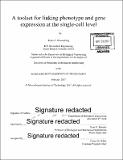A toolset for linking phenotype and gene expression at the single-cell level
Author(s)
Kimmerling, Robert J
DownloadFull printable version (17.49Mb)
Other Contributors
Massachusetts Institute of Technology. Department of Biological Engineering.
Advisor
Scott R. Manalis.
Terms of use
Metadata
Show full item recordAbstract
The development of single-cell RNA-sequencing has led to a new degree of resolution in the characterization of complex, heterogeneous biological systems. However, existing methods are often limited in their ability to link these whole-transcriptome profiles with complimentary measurements of single-cell phenotype. In this thesis we present a microfluidic toolset which allows us to link a panel of single-cell phenotypic measurements - including lineage history, cell cycle stage, cell size, and growth rate - with their corresponding transcriptional profiles. Using a microfluidic platform that employs an array of hydrodynamic traps to capture and culture single cells for multiple generations we measured single-cell growth kinetics, lineage hierarchies and cell cycle stage. By subsequently releasing individual cells from this device for downstream scRNA-seq we were able to generate whole-transcriptome profiles of primary, activated murine CD8+ T cell and lymphocytic leukemia cell line lineages. For both cell types we found distinct transcriptional patterns associated with single-cell lineage relationships as well as cell cycle progression. In order to link single-cell size and growth rate measurements with gene expression, we have also developed a system that relies on an array of suspended microchannel resonators (SMR) - high resolution single-cell buoyant mass sensors - in combination with an automated method of isolating single cells to conduct scRNA-seq downstream. Using this platform, we were able to collect linked transcriptional and biophysical measurements for a murine leukemia cell line, primary murine CD8+ T cells, and a patient-derived glioblastoma multiforme (GBM) cell line. For all cell models measured, we found that single-cell buoyant mass showed a strong correlation with the expression of cell cycle genes. Furthermore, we found that single-cell growth rate and buoyant mass measurements can be used to characterize the degree to which GBM cells respond to drug treatment as well as determine transcriptional signatures associated with response and resistance. Taken together, we believe these single-cell phenotypic measurements will offer complementary contextual information to further resolve the heterogeneity of single-cell transcriptional data. As such, we expect these platforms to be broadly useful to fields where heterogeneous populations of cells display distinct clonal trajectories, including immunology, cancer, and developmental biology.
Description
Thesis: Ph. D., Massachusetts Institute of Technology, Department of Biological Engineering, 2017. Cataloged from PDF version of thesis. Includes bibliographical references (pages 139-142).
Date issued
2017Department
Massachusetts Institute of Technology. Department of Biological EngineeringPublisher
Massachusetts Institute of Technology
Keywords
Biological Engineering.